|
|
Trail HAPPENINGS November 2014
|
A New Look for the Hike to Jeep Arch
by Marc Thomas |
|
Jeep Arch, otherwise known as Gold Bar Arch, is a great destination for a scenic hike. The freshly marked 4-mile roundtrip trail on Bureau of Land Management, (BLM) land is a favorite of local hikers. This is a trail where we often take our out of town visiting friends. The BLM, has made in an ongoing effort to create more clearly marked hiking trails to implement their Resource Management Plan. The designated Jeep Arch route is marked with rock cairns to help eliminate the multiple trails, thereby preserving the fragile desert soil. This hike leads to a striking jeep-shaped arch set in a long sandstone wall.
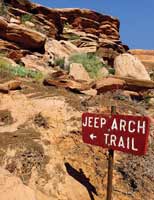 To reach the unmarked trail head, drive north out of Moab on Hwy 191, then turn onto the Potash Road, Hwy 279.The unmarked pullout for the trail up Culvert Canyon to Jeep Arch is on the north side of the road, a third of a mile past the Corona Arch trail parking lot, but before the nearby Gold Bar campground, which provides additional parking if needed. Most of time your vehicle may be the only one at the Culvert Canyon turnout, with only birds and other small creatures keeping you company. Walk through the very large culvert, passing under the railroad tracks, then immediately look to your left for the Jeep Arch directional trail sign. The sign directs you out of the wash to the left, through a dilapidated metal fence and up towards the railroad tracks. The trail makes an obvious right-hand turn up a stone and sand ramp, climbing shortly through another broken fence to a slickrock bench with great views of the Colorado River on your right. To reach the unmarked trail head, drive north out of Moab on Hwy 191, then turn onto the Potash Road, Hwy 279.The unmarked pullout for the trail up Culvert Canyon to Jeep Arch is on the north side of the road, a third of a mile past the Corona Arch trail parking lot, but before the nearby Gold Bar campground, which provides additional parking if needed. Most of time your vehicle may be the only one at the Culvert Canyon turnout, with only birds and other small creatures keeping you company. Walk through the very large culvert, passing under the railroad tracks, then immediately look to your left for the Jeep Arch directional trail sign. The sign directs you out of the wash to the left, through a dilapidated metal fence and up towards the railroad tracks. The trail makes an obvious right-hand turn up a stone and sand ramp, climbing shortly through another broken fence to a slickrock bench with great views of the Colorado River on your right.
From here on, the moderately-ascending trail is cairned all the way on the bench above the canyon floor. The stacked rock cairns are sometimes placed far apart, but readily apparent as you pan the area in front of you.
At a little over a half mile in, the route curves to the left, as it crosses a fairly large drainage following the contours of the canyon. Stay alert for the cairns that lead you in and out of the washes.
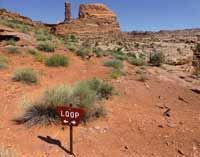 As you hike up-canyon, you will enjoy ever improving views of the sandstone terraces and walls cascading down from the Gold Bar Rim, the high ridge above you, popular with both bikers and jeepers. As you hike up-canyon, you will enjoy ever improving views of the sandstone terraces and walls cascading down from the Gold Bar Rim, the high ridge above you, popular with both bikers and jeepers.
A little over a mile from the trailhead, views open on the left to a saddle between a sandstone fin and an impressive stone spire. The trail comes to a junction below the spire, splitting into upper and lower routes, which form a loop. Both branches will get you to Jeep Arch, but I much prefer the route that climbs into the saddle next to the spire. Although this is the steepest part of the hike, the expansive views more than make up for the short steep trail section. More importantly, it is a much easier walk the rest of the way across scrub flats from the spire to spectacular Jeep Arch. The lower route below the sandstone walls is more primitive, and you need to keep a sharp eye out for where the cairns are placed, as this route is more lightly marked.
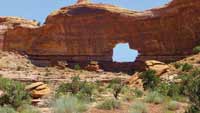 The trail from the spire gradually ascends for half a mile before offering a great view of the arch. Once you are beneath the arch, you will be gazing around for a way to climb into its now substantial opening. Access up into the arch is provided by a fluted stone ramp just to its left. Oftentimes, the wind rushes through arch’s high window, cooling you on a hot day and causing you to reach for a jacket on a cooler one. Enjoy the panoramic canyon country views that unfold in front or behind you. When your reverie is over, you can close the loop by hiking down the route “behind” the arch and traversing right on rock-strewn benches, following cairns until you’re once again standing beneath the spire. The trail from the spire gradually ascends for half a mile before offering a great view of the arch. Once you are beneath the arch, you will be gazing around for a way to climb into its now substantial opening. Access up into the arch is provided by a fluted stone ramp just to its left. Oftentimes, the wind rushes through arch’s high window, cooling you on a hot day and causing you to reach for a jacket on a cooler one. Enjoy the panoramic canyon country views that unfold in front or behind you. When your reverie is over, you can close the loop by hiking down the route “behind” the arch and traversing right on rock-strewn benches, following cairns until you’re once again standing beneath the spire.
As you finish your hike, you may run into someone, as I did, who’s tried but never found Jeep Arch before, you can let them know that the route is now marked throughout with rock cairns.
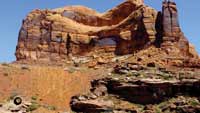 Hiking this trail is most comfortable in the spring and fall when temperatures are mild. If you hike it in the summer, do it early in the day and take plenty of water. Always let someone know where you are headed for your hike. Hiking this trail is most comfortable in the spring and fall when temperatures are mild. If you hike it in the summer, do it early in the day and take plenty of water. Always let someone know where you are headed for your hike.
About the author: Living in the Midwest, I was a labor market analyst and urban planner specializing in demographic data for nearly 30 years. A spur-of-the-moment decision to visit southeast Utah in 1992 led to many subsequent trips and the decision to move here with my wife after we both retired in 2006. I now volunteer for the Sierra Club, Trail Mix, and Friends of Arches and Canyonlands, and have served 6 years as president of the Orchard Villa Homeowners Association.
 Trail Mix This committee represents non motorized trail users including: bikers, hikers, equestrians, and skiers. Many government agencies and private citizens comprise the “mix” that makes this group work so well. We meet the 2nd Tues. of each month from 12-2 at the Grand Center (500W. 182 N.). Everyone is welcome. Trail Mix This committee represents non motorized trail users including: bikers, hikers, equestrians, and skiers. Many government agencies and private citizens comprise the “mix” that makes this group work so well. We meet the 2nd Tues. of each month from 12-2 at the Grand Center (500W. 182 N.). Everyone is welcome.
Contact Sandy Freethey 259-0253 or find us online: wwwgrandcountyutah.net/trailmix/ or at moabtrailmixinfo@gmail.com.
|
|
Adapting for Survival
by Crystal Carpenter (Ranger at Dead Horse Point State Park) |
The adaptations of desert plants tantalize my nerdy naturalist side. Adapting the roots, leaves, seeds, sexual parts, photosynthetic processes, and physical characteristics, they have mastered life in this tenuous desert. With average precipitation marked at 11 inches annually, retaining water becomes the challenge for plants. They do receive help in this endeavor from the symbiotic relations between five life forms that make up the biological soil crust found throughout the Colorado Plateau. Moss, lichen, algae, fungus and cyanobacteria work together to bind the soil, fix nitrogen in the soil, retain water, and provide a good place for seeds to take hold, all of which benefit the plants it surrounds.
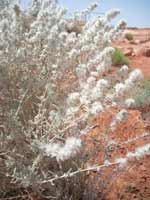 In the desert where rain rarely soaks the ground more than an inch deep, having a deep root system would be counterproductive. Desert plants have one long tap root to keep them rooted into the ground making it difficult for mammals to pluck them from the ground and many shallow roots to absorb the limited water found near the soil surface. Quick absorption of any water resource before the sun heats the soil and evaporates all the water is critical for plants found in the desert. In the desert where rain rarely soaks the ground more than an inch deep, having a deep root system would be counterproductive. Desert plants have one long tap root to keep them rooted into the ground making it difficult for mammals to pluck them from the ground and many shallow roots to absorb the limited water found near the soil surface. Quick absorption of any water resource before the sun heats the soil and evaporates all the water is critical for plants found in the desert.
For one of the few deciduous trees found in the desert, Singleleaf ash, Fraxinus anomala grow round broad leaves, this seems so flagrant and showy considering that most desert plants have tiny leaves or no leaves at all. This ash is able to pull it off since it is able to shed its leaves anytime of the year. If drought conditions exist, it will shed the majority of its leaves. Within two weeks of water returning to the area, it will produce new leaves. A quick response to changing conditions allows this broad leaved tree to survive with limited water resources.
Some desert trees and shrubs will trade in broad leaves for tightly rolled leaves or jointed segments. Mormon tea, Ephedra viridous has jointed segments where photosynthesis occurs while juniper, Juniperus osteosperma have tightly rolled leaves that are stacked upon each other. This reduction in the leaf surface area helps reduce loss of water through transpiration. They double down on the deal by adding a waxy coating making it difficult for water to dissipate from the leaves.
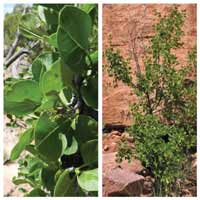 Most of the annual flowers and forbs that emerge in the spring are prolific seed makers. The beauty of the seed is not in the quantity released by the dying plant, but in the water resistant coating that surrounds the seed. It takes a ton of soaking from water before this coating is removed, promoting the seed to germinate. This is crucial to avoid germination during the monsoon season between July and September, to avoid the high temperatures that arrive between thunderstorms which would kill the young plant. Most of the annual flowers and forbs that emerge in the spring are prolific seed makers. The beauty of the seed is not in the quantity released by the dying plant, but in the water resistant coating that surrounds the seed. It takes a ton of soaking from water before this coating is removed, promoting the seed to germinate. This is crucial to avoid germination during the monsoon season between July and September, to avoid the high temperatures that arrive between thunderstorms which would kill the young plant.
As far as sexual adaptations, Four-wing saltbush, Atriplex canescens is the champion. This plant can be dioecious (female and male flowers on separate plants), monoecious (both female and male flowers on same plant), bisexual (female and male sexual organs in same flower) or it can change its sex from year to year as needed. This adaptation reminds me of Virginia Woolf’s novel Orlando, in which the main character changes sex halfway through life. This is one method of adapting to ensure the continuation of a species by increasing the odds of pollination.
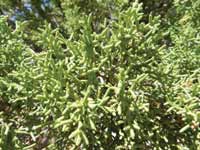 For a few desert plants, changing the process of photosynthesis gives them a method to conserve precious water reserves. Crassulacean Acid Metabolism or CAM photosynthesis allows cacti and succulents to only open their stomata for gas exchange during the night, thus reducing water loss through open stomata during the day. The carbon dioxide is stored within the plant cells as an organic acid during the day. The Calvin cycle continues without the stomata opening. During the cooler night hours, the stomata will open to complete gas exchange. This is a very simplistic take on CAM photosynthesis which is actually a rather complex process. For a few desert plants, changing the process of photosynthesis gives them a method to conserve precious water reserves. Crassulacean Acid Metabolism or CAM photosynthesis allows cacti and succulents to only open their stomata for gas exchange during the night, thus reducing water loss through open stomata during the day. The carbon dioxide is stored within the plant cells as an organic acid during the day. The Calvin cycle continues without the stomata opening. During the cooler night hours, the stomata will open to complete gas exchange. This is a very simplistic take on CAM photosynthesis which is actually a rather complex process.
In the desert, the shade can be several degrees cooler than in the direct sun. Winterfat, Krascheninnikovia lanata shades itself from direct sunlight with trichomes (tiny hairs). It is quite striking to see the white hairs illuminated by the evening sun, set in a backdrop of red rock. By reduction of direct sunlight on the leaves, water is conserved. Common prickly pear will use long spines to shade its fleshy sides from direct sun, for desert plants trying to conserve every bit of water possible, staying cooler results in less water loss from transpiration.
Adapting to low water intake and developing unique methods to conserve water allows a variety of plants to survive under extremely harsh conditions with wild fluctuations. Being able to taken in water as quickly as possible and keep whatever water is absorbed is crucial to these desert plants and for the animals that depend on them.
|
|
|
|
|
|
© 2002-2024 Moab Happenings. All rights
reserved.
Reproduction of information contained in this site is
expressly prohibited.
|
|
 To reach the unmarked trail head, drive north out of Moab on Hwy 191, then turn onto the Potash Road, Hwy 279.The unmarked pullout for the trail up Culvert Canyon to Jeep Arch is on the north side of the road, a third of a mile past the Corona Arch trail parking lot, but before the nearby Gold Bar campground, which provides additional parking if needed. Most of time your vehicle may be the only one at the Culvert Canyon turnout, with only birds and other small creatures keeping you company. Walk through the very large culvert, passing under the railroad tracks, then immediately look to your left for the Jeep Arch directional trail sign. The sign directs you out of the wash to the left, through a dilapidated metal fence and up towards the railroad tracks. The trail makes an obvious right-hand turn up a stone and sand ramp, climbing shortly through another broken fence to a slickrock bench with great views of the Colorado River on your right.
To reach the unmarked trail head, drive north out of Moab on Hwy 191, then turn onto the Potash Road, Hwy 279.The unmarked pullout for the trail up Culvert Canyon to Jeep Arch is on the north side of the road, a third of a mile past the Corona Arch trail parking lot, but before the nearby Gold Bar campground, which provides additional parking if needed. Most of time your vehicle may be the only one at the Culvert Canyon turnout, with only birds and other small creatures keeping you company. Walk through the very large culvert, passing under the railroad tracks, then immediately look to your left for the Jeep Arch directional trail sign. The sign directs you out of the wash to the left, through a dilapidated metal fence and up towards the railroad tracks. The trail makes an obvious right-hand turn up a stone and sand ramp, climbing shortly through another broken fence to a slickrock bench with great views of the Colorado River on your right. As you hike up-canyon, you will enjoy ever improving views of the sandstone terraces and walls cascading down from the Gold Bar Rim, the high ridge above you, popular with both bikers and jeepers.
As you hike up-canyon, you will enjoy ever improving views of the sandstone terraces and walls cascading down from the Gold Bar Rim, the high ridge above you, popular with both bikers and jeepers. The trail from the spire gradually ascends for half a mile before offering a great view of the arch. Once you are beneath the arch, you will be gazing around for a way to climb into its now substantial opening. Access up into the arch is provided by a fluted stone ramp just to its left. Oftentimes, the wind rushes through arch’s high window, cooling you on a hot day and causing you to reach for a jacket on a cooler one. Enjoy the panoramic canyon country views that unfold in front or behind you. When your reverie is over, you can close the loop by hiking down the route “behind” the arch and traversing right on rock-strewn benches, following cairns until you’re once again standing beneath the spire.
The trail from the spire gradually ascends for half a mile before offering a great view of the arch. Once you are beneath the arch, you will be gazing around for a way to climb into its now substantial opening. Access up into the arch is provided by a fluted stone ramp just to its left. Oftentimes, the wind rushes through arch’s high window, cooling you on a hot day and causing you to reach for a jacket on a cooler one. Enjoy the panoramic canyon country views that unfold in front or behind you. When your reverie is over, you can close the loop by hiking down the route “behind” the arch and traversing right on rock-strewn benches, following cairns until you’re once again standing beneath the spire. Hiking this trail is most comfortable in the spring and fall when temperatures are mild. If you hike it in the summer, do it early in the day and take plenty of water. Always let someone know where you are headed for your hike.
Hiking this trail is most comfortable in the spring and fall when temperatures are mild. If you hike it in the summer, do it early in the day and take plenty of water. Always let someone know where you are headed for your hike. Trail Mix This committee represents non motorized trail users including: bikers, hikers, equestrians, and skiers. Many government agencies and private citizens comprise the “mix” that makes this group work so well. We meet the 2nd Tues. of each month from 12-2 at the Grand Center (500W. 182 N.). Everyone is welcome.
Trail Mix This committee represents non motorized trail users including: bikers, hikers, equestrians, and skiers. Many government agencies and private citizens comprise the “mix” that makes this group work so well. We meet the 2nd Tues. of each month from 12-2 at the Grand Center (500W. 182 N.). Everyone is welcome. In the desert where rain rarely soaks the ground more than an inch deep, having a deep root system would be counterproductive. Desert plants have one long tap root to keep them rooted into the ground making it difficult for mammals to pluck them from the ground and many shallow roots to absorb the limited water found near the soil surface. Quick absorption of any water resource before the sun heats the soil and evaporates all the water is critical for plants found in the desert.
In the desert where rain rarely soaks the ground more than an inch deep, having a deep root system would be counterproductive. Desert plants have one long tap root to keep them rooted into the ground making it difficult for mammals to pluck them from the ground and many shallow roots to absorb the limited water found near the soil surface. Quick absorption of any water resource before the sun heats the soil and evaporates all the water is critical for plants found in the desert. Most of the annual flowers and forbs that emerge in the spring are prolific seed makers. The beauty of the seed is not in the quantity released by the dying plant, but in the water resistant coating that surrounds the seed. It takes a ton of soaking from water before this coating is removed, promoting the seed to germinate. This is crucial to avoid germination during the monsoon season between July and September, to avoid the high temperatures that arrive between thunderstorms which would kill the young plant.
Most of the annual flowers and forbs that emerge in the spring are prolific seed makers. The beauty of the seed is not in the quantity released by the dying plant, but in the water resistant coating that surrounds the seed. It takes a ton of soaking from water before this coating is removed, promoting the seed to germinate. This is crucial to avoid germination during the monsoon season between July and September, to avoid the high temperatures that arrive between thunderstorms which would kill the young plant. For a few desert plants, changing the process of photosynthesis gives them a method to conserve precious water reserves. Crassulacean Acid Metabolism or CAM photosynthesis allows cacti and succulents to only open their stomata for gas exchange during the night, thus reducing water loss through open stomata during the day. The carbon dioxide is stored within the plant cells as an organic acid during the day. The Calvin cycle continues without the stomata opening. During the cooler night hours, the stomata will open to complete gas exchange. This is a very simplistic take on CAM photosynthesis which is actually a rather complex process.
For a few desert plants, changing the process of photosynthesis gives them a method to conserve precious water reserves. Crassulacean Acid Metabolism or CAM photosynthesis allows cacti and succulents to only open their stomata for gas exchange during the night, thus reducing water loss through open stomata during the day. The carbon dioxide is stored within the plant cells as an organic acid during the day. The Calvin cycle continues without the stomata opening. During the cooler night hours, the stomata will open to complete gas exchange. This is a very simplistic take on CAM photosynthesis which is actually a rather complex process.